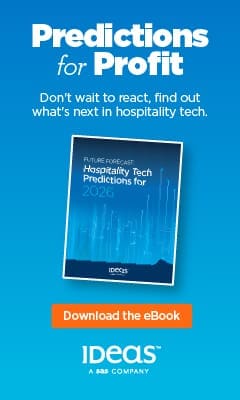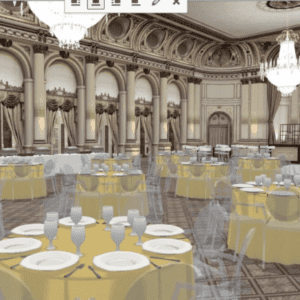 Hotel reviews and guest feedback are critical for determining what’s meaningful for the guest. We all understand this, because oftentimes the fixes that will generate the most ROI are not necessarily the most expensive. Call it ‘value engineering’ whereby the more guest feedback you get the more you have to go on to improve operations which then translates into more guest satisfaction, the ability to command higher rates and, ultimately, healthier NOI or property valuations.
Hotel reviews and guest feedback are critical for determining what’s meaningful for the guest. We all understand this, because oftentimes the fixes that will generate the most ROI are not necessarily the most expensive. Call it ‘value engineering’ whereby the more guest feedback you get the more you have to go on to improve operations which then translates into more guest satisfaction, the ability to command higher rates and, ultimately, healthier NOI or property valuations.
In this sense, there’s a positive feedback loop between guest feedback and long-term asset value, making the former an instructional aspect of hotel operations that hoteliers simply must pay more attention to. Knowing this, the question then becomes how do hotels get more feedback (either on TripAdvisor, an OTA or direct to the brand) so that there’s more information to guide opex or capex.
With this question, what’s striking about the hotel industry is there’s no formal training on survey design. It’s actually a glaring gap for which we were honored to sit down with Jeff Robbins, founder of GuestInsight, to learn about what hotels can do to rapidly scale their total guest engagement so that management can better decide what projects have the best near-term and long-term ROI from the guests’ perspective.
Yes, GuestInsight is a vendor with a platform to help hoteliers collect, analyze and automate their guest feedback. Push the technology aside for a moment and the problem remains: hotels still need qualified personnel to govern their feedback systems in order to elicit the most data from customers.
With this in mind, one of us (Adam) first met Robbins at ILC Cultivate this past summer in New York to go through this challenge. It turns out that GuestInsight is an established player in the survey space, bringing with it over two decades of deep experience in survey design and applying this expertise daily via ongoing customer support so that hotels can realize the benefit of asking the right questions that engage guests in the right way.
Of the top, some survey design tips that Robbins suggests based on current work with GuestInsight clients include:
- Messaging that demonstrates a respect for the guest’s time and inbox
- Messaging that clearly defines the ask in terms of reason and time expectations
- Stating outright how important the effort of collecting feedback is for the hotel
- Being transparent about recruiting an experienced outside agency to manage the process
- Mentioning how the guest’s anonymity and privacy will be protected
- Having a responsive survey interface with reliably quick load times
- Not bundling the feedback request with a sales effort
- Having an alert mechanism in place so that teams can immediately tackle an error recovery situation or when the surveys are used for post-departure requests like making another booking
- Being cognizant of a team’s overall ‘alert fatigue’ when setting up said alert mechanisms
Above all, Robbins emphasized that surveys must be structured in a way that accomplishes the research goals with the least amount of effort required by the guest according to these three principles:
- Question sequencing that prioritizes specified feedback goals
- Question wording or question format selection with precise and concise language to elicit results
- Flexibility in adapting the survey with seasonal or monthly updates to the questions in order to test new ideas as well as stress certain facilities or services
Now with that human ‘judgment’ covered, let’s circle back to technology because, ultimately, surveys need to be automated in order to achieve any semblance of labor savings. In November 2023, it’s inevitable for AI to enter the conversation, either as natural language processing (NLP) to help scale sentiment analysis or another form of machine learning (ML) that finds patterns in the multitude. And as any IT professional knows, the amount of data hotels currently have is becoming overwhelming; AI will be pivotal to help guide this managerial judgment.
From the above tips, though, what’s apparent is that these technologies are just tools; they belie the need for veteran oversight to help hotels maximize the usage of the totality of data for any algorithm to chew on. Hence, the act of setting up then updating questionnaires shouldn’t be the sole responsibility of the hotelier who isn’t formally trained in survey design and cannot provide this adept oversight.
The risk nowadays is that if feedback response rates remain low, then the data won’t be big enough for an AI to accurately interpret. Simultaneously, of course, some of that ‘significance’ also won’t rise to the top to present those value-engineered solutions that will inform operational planning and future investments in a meaningful way that will increase long-term asset value.
Then on another note aside from AI, we pressed Robbins for an example of past work because we often learn best through stories rather than the abstract. Working with a 120-room independent property in Silicon Valley, the GuestInsight platform was able to drastically ramp up the number of completed surveys, with a year-to-date total of 819 internal completed surveys compared to 12 reviews on TripAdvisor, 67 on Google and 193 on Booking.
With over 20 times the number of surveys versus TripAdvisor reviews, this uptick in both the quantity and pace at which data was accumulating meant that the hotel was able to rapidly spot a significant trend from its declining scores and guest comments. Specifically, the breakfast offering was changed during the pandemic and was initially positively received, so the hotel kept it in place. But during the late spring months of 2023, this perception shifted and was quickly spotted by the metrics which started to trail off at the same time.
From this observation, amidst the hectic summer period the team was able to upgrade its breakfast service back to and beyond its pre-pandemic levels, with this positive, cost-effective change reflected in the post hoc responses.
Overall, these sorts of minute-by-minute inferences are only possible when there’s proper survey design in place to maximize response rates and the amount of data received. And when you are able to spot enough of these trends, you ensure that no issue goes unnoticed and that the hotel is maximizing satisfaction to thereafter influence brand advocacy, the ability to grow ADR and, specifically for owners, long-term asset value.
This article may not be reproduced without the expressed permission of the authors.



















